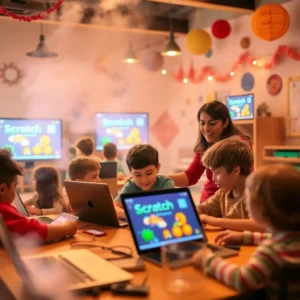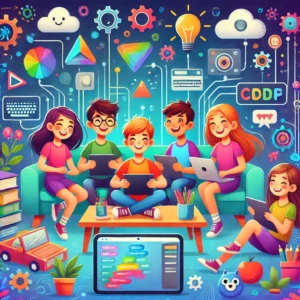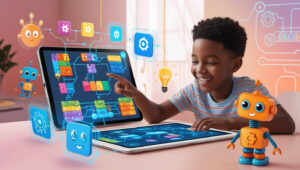Introduction
In today’s tech-driven world, coding has become an essential skill for kids. It nurtures creativity, enhances problem-solving, and prepares children for a future where technology plays a pivotal role. While coding courses and tools can be expensive, there are numerous free coding resources for kids that provide excellent learning opportunities without breaking the bank.
This guide explores the best free platforms, tools, and strategies for helping kids of all ages explore the world of coding.
Why Coding is Crucial for Kids
Coding isn’t just about writing lines of code; it’s about developing critical thinking, logical reasoning, and creativity. Here’s why introducing kids to coding early is essential:
- Future-Ready Skills: Technology is reshaping industries. Skills like coding, robotics, and data literacy give kids a competitive edge.
- Encourages Creativity: Kids can design games, build apps, and create animations, turning their ideas into reality.
- Boosts Academic Performance: Coding improves problem-solving, which can enhance performance in subjects like math and science.
- Prepares for STEM Careers: Many future jobs require basic programming knowledge, making early exposure invaluable.
Top Free Coding Resources for Kids
Here’s a breakdown of the best free platforms and tools in 2024:

- Scratch
- Age Group: 8–16 (ScratchJr for ages 5–7)
- Features:
- Drag-and-drop programming blocks.
- Create interactive stories, games, and animations.
- Vibrant online community for sharing projects.
- Why It’s Great:
- Simplifies complex coding concepts.
- Encourages creativity and collaboration.
- Website: scratch.mit.edu
- Code.org
- Age Group: K-12
- Features:
- Hour of Code: Short, interactive coding challenges.
- Courses with themes like Minecraft and Star Wars.
- Lessons on loops, functions, and conditionals.
- Why It’s Great:
- Engaging and intuitive.
- Ideal for absolute beginners.
- Website: code.org
- Tynker
- Age Group: 7–12
- Features:
- Learn to code through games and challenges.
- Free courses include Minecraft modding and robotics.
- Why It’s Great:
- Progression from block-based coding to Python and JavaScript.
- Website: tynker.com
- Khan Academy
- Age Group: 10+
- Features:
- Courses in JavaScript, HTML/CSS, and SQL.
- Interactive coding challenges.
- Why It’s Great:
- Clear, structured lessons.
- Encourages self-paced learning.
- Website: khanacademy.org
- Blockly
- Age Group: 6–10
- Features:
- Visual block-based coding platform.
- A step-by-step approach to programming.
- Why It’s Great:
- Simple interface perfect for beginners.
- Website: blockly.games
- Grasshopper
- Age Group: Teens
- Features:
- Mobile app for learning JavaScript.
- Fun, interactive lessons.
- Why It’s Great:
- Great for on-the-go learning.
- Website: grasshopper.app
- FreeCodeCamp
- Age Group: Teens and advanced learners
- Features:
- Hands-on coding projects.
- Certifications in JavaScript, Python, and more.
- Why It’s Great:
- Practical, real-world coding challenges.
- Website: freecodecamp.org
- Lightbot
- Age Group: 4–9
- Features:
- Coding through puzzle-solving.
- Teaches sequencing and loops.
- Why It’s Great:
- Engaging and accessible for young learners.
- Website: lightbot.com
How to Get Kids Interested in Coding
- Start Small: Use beginner-friendly tools like Scratch or Blockly.
- Make It Fun: Introduce coding through games, animations, and storytelling.
- Encourage Projects: Let kids create their apps, games, or websites.
- Combine with STEM: Integrate robotics kits or STEM toys for hands-on learning.
- Set Goals: Reward progress to keep kids motivated.
Common Challenges in Teaching Kids to Code
- Screen Time Concerns: Balance coding lessons with offline activities.
- Accessibility: Use free tools to eliminate cost barriers.
- Maintaining Interest: Relate coding projects to kids’ hobbies, like gaming or art.
Benefits of Coding for Kids
- Improves Logical Thinking: Kids learn to break problems into smaller, solvable parts.
- Encourages Resilience: Debugging teaches patience and persistence.
- Promotes Collaboration: Group coding activities enhance teamwork skills.
- Builds Confidence: Completing projects boosts self-esteem.
Conclusion
Coding is more than a skill; it’s a gateway to creativity, critical thinking, and future success. With the abundance of free coding resources for kids, there’s no better time to introduce your child to programming. From platforms like Scratch and Code.org to mobile apps like Grasshopper, these tools make learning engaging and fun.
Start exploring today and watch your child develop skills shaping their future!





